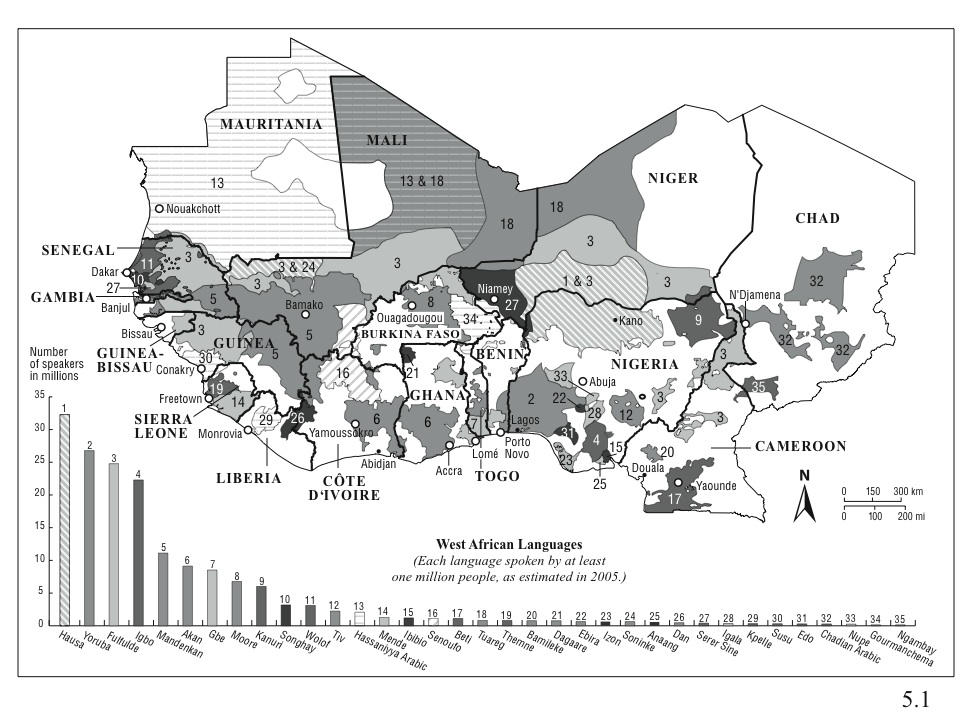One can certainly see part of the point the Guardian makes about the Tuareg/Moor/Arab groups and the Mali army. As I have written before two major ethnic groups seem to dominate in the northern provinces.
The Songhai seem to be farmers and should be thus mostly be settled in the souther areas of the northern provinces, along the riverbeds and lakes, especially of course along the great Niger. Ok, this ethnic map ( from the African Art Virtual Gallery ) seems to give a general idea of the situation. Note that quite some of the recent fighting took place in the traditional homeland of the Songhai, in areas where relative little Tuareg live. (Both Songhay and Songhai seem to be valid).Mali's population consists of diverse Sub-Saharan ethnic groups, sharing similar historic, cultural, and religious traditions. Exceptions are two nomadic northern groups, the Tuaregs, a Berber people, and Maurs (or Moors), of Arabo-Berber origins. The Tuaregs traditionally have opposed the central government. Starting in June 1990 in the north, Tuaregs seeking greater autonomy led to clashes with the military. In April 1992, the government and most opposing factions signed a pact to end the fighting and restore stability in the north. Its major aims are to allow greater autonomy to the north and increase government resource allocation to what has been a traditionally impoverished region. The peace agreement was celebrated in 1996 in Timbuktu during an official and highly publicized ceremony called "Flamme de la Paix"--(peace flame).
Historically, interethnic relations throughout the rest of the country were facilitated by easy mobility on the Niger River and across the country's vast savannahs. Each ethnic group was traditionally tied to a specific occupation, all working within proximity to each other, although the distinctions were often blurred. The Bambara, Malink, Sarakole, Dogon and Songhay are farmers; the Fula or Fulani, Maur, and Tuareg are herders, while the Bozo are fishers. In recent years, this linkage has shifted considerably, as ethnic groups seek diverse, nontraditional sources of income.
Ethnic groups: Mande 50% (Bambara, Malinke, Soninke), Fula[5] 17%, Voltaic 12%, Songhai 6%, Tuareg and Moor 10%, other 5%
From the Guardian:
This linguistic map ( from the Fragile states center) shows a similar picture in the specific area:Even if the Malian and Ecowas troops manage to march in and recapture most of the major cities in the north, they're likely to find their enemy strangely invisible. The local youth who have been fighting for one or other of the Islamist katibat or cells will no doubt stash their Kalashnikovs, khaki robes and ammo pouches and don the uniform of the local inhabitants; a civilian robe and a turban that covers the head and face, leaving only the eyes exposed. A junior army officer from Lagos, Cotonou or even Bamako will find it very hard to tell the Islamist apart from the innocent native city-dweller or nomad. Local informants will offer their services and summary executions and brutality against both the guilty and the innocent will ensue. Anger against "white" northerners - Tuareg, Arab and Fulani – that has been brewing among southern black Malians and the darker skinned northerners such as the Songhoi is likely to spill over into racial and ethnic violence. Vigilante groups, such as the feared Songhoi militia, the Ganda Izo, are ready to roar into action with their machetes and petrol cans. Human rights organisations will have to work overtime.
It is of course of great importance to partly ignore the state borders, especially under the present circumstances, Afghanistan docet. The raid in Algeria was certain not needed to give further prove of that.
Guardian:
In this case it was a raid out of the traditional Moorish homeland (in Mauritania) into a Southern/Central region of Mali populated by quite different ethnic and linguistic groups. With a vast area of relatively speedily crossed terrain and a rather ineffective army it is no surprise that small organized forces with enough pickups and fuel can mount such strikes.This is the land where the local Tuareg or Arab in his souped-up turbo 4x4 is king. Iyad Ag Ghali, the Tuareg leader of the Salafist Ansar Dine militia, is a master of the kind of hit-and-run guerrilla warfare that suits the desert conditions and the sheer size of territory, roughly equal to that of Spain. His mujahideen showed their verve last Sunday by capturing the small town of Diabaly, north of Mopti, with a lightening strike that originated over the border in Mauritania. This ability to crisscross borders is another important aspect of the Islamists' Houdini-esque style of combat.








 Reply With Quote
Reply With Quote

Bookmarks